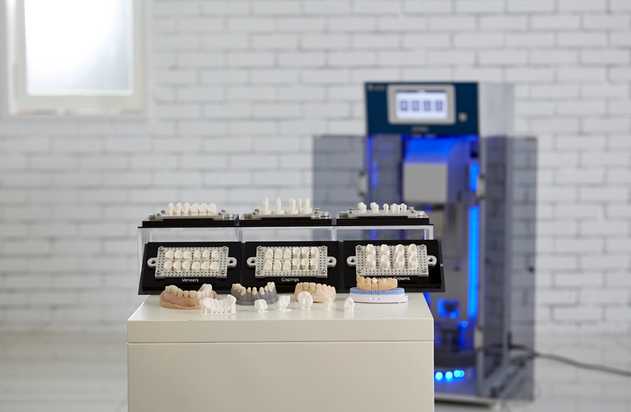 AON Co. has built upon its experience with the INNI lineup to provide a brand new series called ZIPRO. Two different versions are available, the ZIPRO Dental and ZIPRO Industrial, to cater to the needs of different types of users.
AON Co. has built upon its experience with the INNI lineup to provide a brand new series called ZIPRO. Two different versions are available, the ZIPRO Dental and ZIPRO Industrial, to cater to the needs of different types of users.
Just as with the INNI series, the Dental version is specifically designed for dental practitioners while the Industrial version suits a broader range of use cases where high-precision ceramic parts are also required.
These top-down DLP 3D printers work with proprietary ZIPROS software that enables professionals to easily upload a file, orient the part, and add automatically generated support structures before slicing and sending the 3D model to the Wi-Fi-enabled ZIPRO printers.
The ZIPRO Dental 3D printer is equipped with a Full HD (1920 x 1080p) light projector that precisely controls UV light intensity to print crispy clean layers as thin as 40 micrometers.
Its automatic leveling system ensures each layer is uniform before the light is projected onto the slurry. We must also acknowledge one of the ZIPRO’s most interesting elements: its easy print removal solution. The build plate is punched with a range of small holes in which, after the printing process is complete, a jig can be inserted to easily pop the parts off the plate.
INNI-CERA Zirconia slurry
AON Co. developed INNI-CERA Zirconia slurry in-house to provide the highest level of detail and accuracy for the dental industry while respecting international quality standards.
This material is fully biocompatible and offers an optimal flexural strength of up to 900Mpa, meeting the requirements for extensive or long-span dental restorations.
INNI-CERA Zirconia is also A2-shade-colored to provide a natural-looking base before further staining to match the patient’s natural discoloration.
What’s the difference between resin and slurry?
AON Co. emphasizes the fact that their material is a slurry rather than a resin, but what’s the difference between the two?
In 3D printing, the resin is a polymer base in which plastics, metals, or ceramics can be added. Slurry, on the other hand, is a semi-liquid mixture filled with particles of plastics, metals, or ceramics that are suspended in water (no polymer base).
While metal or ceramic-based resins do exist, the term resin is primarily used for polymer and plastic-based stereolithography materials, while the word slurry is more specific to liquid ceramic materials.
A slurry offers a higher concentration of ceramic materials which, furthermore, are uncontaminated by plastics or polymers which aren’t always food-safe or biocompatible.
In addition, parts 3D printed with AON Co.’s INNI-CERA are “green” and must undergo an added sintering step, offering higher strength compared to non-sintered ceramic resin. Generally, sintering parts can cause them to shrink, but AON Co.’s R&D team has worked on providing optimal shrinkage ratios.
www.aoninni.com